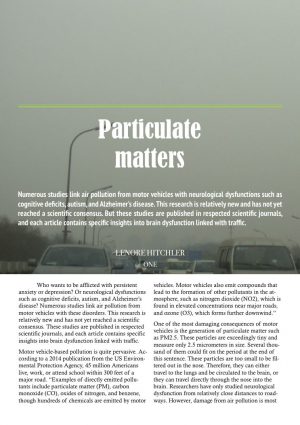 Who wants to be afflicted with persistent anxiety or depression? Or neurological dysfunctions such as cognitive deficits, autism, and Alzheimer’s disease? Numerous studies link air pollution from motor vehicles with these disorders. This research is relatively new and has not yet reached a scientific consensus. These studies are published in respected scientific journals, and each article contains specific insights into brain dysfunction linked with traffic.
Who wants to be afflicted with persistent anxiety or depression? Or neurological dysfunctions such as cognitive deficits, autism, and Alzheimer’s disease? Numerous studies link air pollution from motor vehicles with these disorders. This research is relatively new and has not yet reached a scientific consensus. These studies are published in respected scientific journals, and each article contains specific insights into brain dysfunction linked with traffic.
Motor vehicle-based pollution is quite pervasive. According to a 2014 publication from the US Environmental Protection Agency, 45 million Americans live, work, or attend school within 300 feet of a major road. “Examples of directly emitted pollutants include particulate matter (PM), carbon monoxide (CO), oxides of nitrogen, and benzene, though hundreds of chemicals are emitted by motor vehicles. Motor vehicles also emit compounds that lead to the formation of other pollutants in the atmosphere, such as nitrogen dioxide (NO2), which is found in elevated concentrations near major roads, and ozone (O3), which forms further downwind.”
One of the most damaging consequences of motor vehicles is the generation of particulate matter such as PM2.5. These particles are exceedingly tiny and measure only 2.5 micrometers in size. Several thousand of them could fit on the period at the end of this sentence. These particles are too small to be filtered out in the nose. Therefore, they can either travel to the lungs and be circulated to the brain, or they can travel directly through the nose into the brain. Researchers have only studied neurological dysfunction from relatively close distances to roadways. However, damage from air pollution is most likely present in control groups as they are likely to also have been exposed to air pollutants. According to the United Nations Environment Programme, air pollutants can travel thousands of kilometers.
Particulate matter is correlated with anxiety. “The Relation Between Past Exposure to Fine Particulate Air Pollution and Prevalent Anxiety: Observational Cohort Study” was published in the British Medical Journal. It reported that “Anxiety disorders, characterized by disruptive fear, worry, and related behavioral disturbances such as avoidance or physical sensations of hyperarousal, are the most common type of psychiatric disorder in the general population. Globally approximately 16% of people will have an anxiety disorder in their lifetime. … In 2010, anxiety disorders accounted for approximately 26.8 million disability adjusted life years worldwide.” This study found an association between exposure to PM2.5 and anxiety.
Besides particulate matter being linked with anxiety, abnormally high levels of carbon dioxide (CO2) are also air pollutants and are linked with anxiety. “Behavioral and Cardiovascular Effects of 7.5% CO2 in Human Volunteers” was published in Depression and Anxiety. Healthy participants who did not have anxiety disorders breathed in air containing 7.5% CO2, and they felt threatened, anxious, tense, and fearful.
Depression is another mental illness correlated with air pollution. “Association of Ambient Air Pollution with Depressive and Anxiety Symptoms in Older Adults: Results from the NSHAP Study” was published in Environmental Health Perspectives. The article stated “PM2.5 exposures may harm mental health through increased neuroinflammation, oxidative stress, cerebro-vascular damage and neurodegeneration. … PM2.5 may also harm mental health by increasing markers of glucocorticoid activity and levels of the stress hormone cortisol.” In this study PM2.5 was associated with both anxiety and depression.
Increased emergency room visits because of depression are correlated with higher amounts of particulate matter as shown in “Air pollution: A Systematic Review of its Psychological, Economic, and Social Effects” published in ScienceDirect.
Particulate matter is also linked with obsessive-compulsive disorders as shown in “The Association Between Anxiety, Traumatic Stress, and Obsessive-Compulsive Disorders and Chronic Inflammation: A Systematic Review and Meta-Analysis” published in Depression and Anxiety. Exposure to air pollution is associated with brain inflammation and the article reported “Inflammation is increasingly implicated as a cofactor in the pathophysiological processes underlying psychiatric disorders.” The analysis of 41 studies led to the conclusion that people with anxiety disorders, PTSD, or obsessive-compulsive disorders have a significantly higher level of pro-inflammatory markers. One study found that “individuals with agoraphobia also demonstrated significantly higher levels of CRP [c-reactive protein].”
Just as some cases of anxiety are linked with air pollution from fossil fuels, so is autism. “Particulate Matter Exposure, Prenatal and Postnatal Windows of Susceptibility, and Autism Spectrum Disorders” was published in Epidemiology. It stated “We found that exposure to PM10 during the third-trimester of pregnancy was associated with increased risk of autism. … Components of traffic pollution cause a systemic inflammatory response. … Evidence suggests that proper brain network development depends on close co-ordination with the immune system, so that disruption in the immune system could affect brain development.”
Another study correlating autism and air pollution is “Traffic-Related Air Pollution, Particulate Matter, and Autism” published in JAMA Psychiatry. During the first year of life, “Children residing in homes with the highest levels of modeled traffic-related air pollution were three times as likely to have autism compared with children residing in homes with the lowest levels of exposure. … Data examining biomarkers suggest that oxidative stress and inflammation may also be involved in the pathogenesis of autism.”
Further corroboration comes from “Autism Spectrum Disorder and Particulate Matter Air Pollution Before, During, and After Pregnancy: A Nested Case-Control Analysis Within the Nurse’s Health Study II Cohort” published in Environmental Health Perspectives. The article reported that “It was estimated there were 50% higher odds of having a child with an ASD [Autism Spectrum Disorder] in women in the highest quartile of estimated PM2.5 exposure throughout pregnancy. … In one study, increased mitochondrial DNA damage, possibly caused by reactive oxygen species, was found to be more common in 67 children with ASD than in 36 typically developing children.”
Besides air pollution being linked with autism, it is also connected with other neurological difficulties. The George Mason University Center for Climate Change Communication published “The Link Between Fossil Fuels and Neurological Harm.” The authors reported “According to the US Department of Energy, over the past 20 years, three-fourths of human-caused emissions were produced from burning fossil fuels. … In 2016, Environmental Health Perspectives published a joint public statement issued by 14 scientific or medical associations and 50 scientists representing the disciplines of pediatrics, toxicology, public health, and neurobiology. The Project TENDR (Targeting Environmental Neurodevelopmental risks) Consensus Statement noted evidence of danger to children in the United States due to air pollution, listing fossil fuel-related air pollutants (including particulate matter, PAHS, [polycyclic aromatic hydrocarbons] and nitrogen dioxide) as prime examples of toxic chemicals that can contribute to learning, behavioral, or intellectual impairment, as well as specific neurodevelopmental disorders such as ADHD [attention deficit hyperactivity disorder] or autism.”
This article referenced additional studies on air pollution and cognition. “A longitudinal study of mothers and children in New York City’s North Harlem produced some of the earliest evidence linking PAH exposure in pregnant women to cognitive defects and behavioral disorders in their children at ages three and five. Three-year-olds exposed prenatally to high levels of PAHs exhibited lower mental development scores on standardized tests and a higher risk for cognitive delays. At age five, they performed lower on IQ tests than children with lower exposure rates. As these children grew older, they continued to exhibit adverse neurological impacts – including anxiety, depression and hyperactivity – compared to children less exposed before birth to PAHs. … A 2018 study published in Biological Psychiatry found that children exposed in utero exhibited a thinner outer layer of the brain (the cortex) at ages six to ten years. These abnormalities were associated with impaired impulse control.”
This article provided still further evidence correlating air pollution and neurological dysfunction. “In a study of 262 children ages 8 to 12, higher exposure to urban traffic pollution was linked to slower brain maturation. … Four studies investigating prenatal exposure to PAHs found links to delayed verbal, psychomotor and/or general development in children. … A 2014 cross-sectional study in the U.S. found an association between postnatal exposure to PAHs and special education needs in boys.”
Cognition is also impaired by excessive amounts of CO2. The article “Is CO2 an Indoor Pollutant? Direct Effects of Low-to-Moderate CO2 Concentrations on Human Decision-Making Performance” was published in Environmental Health Perspectives. It states “outdoor levels in urban areas as high as 500 ppm have been reported. Concentrations of CO2 inside buildings range from outdoor levels up to several thousand parts per million. … In surveys of elementary school classrooms in California and Texas, average CO2 concentrations were >1,000 ppm, a substantial proportion exceed 2,000 ppm, and in 21% of Texas classrooms peak CO2 concentrations exceed 3,000 ppm. … At 1,000 ppm CO2, compared with 600 ppm, performance was significantly diminished on six of nine metrics of decision-making performance.” CO2 is the key regulator of “arousal of behavioral states” which suggests a way in which CO2 affects the brain.
The following two articles also correlate carbon dioxide and cognitive difficulties. “Fossil Fuel Combustion is Driving Indoor CO2 Toward Levels Harmful to Human Cognition” was published in GeoHealth. The authors state that “Studies focusing on school environments have found impacts of CO2 on standardized test scores, and attendance, and significant deterioration of attention, vigilance, memory, and concentration when CO2 levels are elevated.” Environmental Health Perspectives published “Associations of Cognitive Function Scores with Carbon Dioxide, Ventilation, and Volatile Organic Compound Exposures in Office Workers: A Controlled Exposure Study of Green and Conventional Office Environments.” The study only lasted six days and not all days were high CO2 days, and nonetheless it found “For seven of the nine cognitive function domains, average cognitive scores decreased at each higher level of CO2.”
Air pollution also damages cognition. “The Impact of Exposure to Air Pollution on Cognitive Performance” was published in PNAS. The authors stated that “long-term exposure to air pollution impeded cognitive performance in verbal and math tests.” Environmental Health Perspectives published “Prenatal and Childhood Traffic-Related Pollution Exposure and Childhood Cognition in the Project Viva Cohort.” In Krakow, Poland, exposure in late pregnancy to PAHs was linked with poorer nonverbal reasoning at 5 years. “In a recent meta-analysis of European birth cohorts, prenatal exposure to ambient air pollution was associated with lower psycho-motor development in children 1-6 years of age.”
The study itself found children living <50 meters away from a major roadway had lower nonverbal IQs, and somewhat lower verbal IQs and visual motor abilities.
Particulate matter also appears damaging to the elderly brain as shown in “Fine Particulate Matter Air Pollution and Cognitive Function Among Older US Adults” published in the American Journal of Epidemiology. The authors reported that “Older adults living in areas with higher PM2.5 concentrations had worse cognitive function.” Translational Psychiatry published “Particulate Air Pollutants, APOE Alleles and Their Contributions to Cognitive Impairment in Older Women and to Amyloidogenesis in Experimental Models.” Living where the PM exceeded EPA standards increased the risk for global cognitive decline by 81% and 92% for all-cause dementia.
The following studies also show the connection of air pollution and dementia. The Lancet published “Living Near Major Roads and the Incidence of Dementia, Parkinson’s Disease, and Multiple Sclerosis: A Population-Based Cohort Study,” The report found “Living close to heavy traffic was associated with a higher incidence of dementia. Ultrafine particles have been found in the olfactory bulb and the frontal critical areas in the brains of highly exposed people to traffic.” The British Medical Journal published “Are Noise and Air Pollution Related to the Incidence of Dementia? A Cohort Study in London, England.” This study found that PM2.5 increased Alzheimer’s rates.
Extreme air pollution is correlated with brain damage similar to Alzheimer’s. “Hallmarks of Alzheimer Disease Are Evolving Relentlessly in Metropolitan Mexico City Infants Children and Young Adults” published in Environmental Research. Autopsies of children showed the same type of damage as found in Alzheimer’s.
Alzheimer’s is one cause of dementia, and according to the Alzheimer’s Association, more than six million Americans have Alzheimer’s, one in three seniors die with Alzheimer’s or another dementia, and in 2021, these diseases will cost $355 billion. Inflammation is a factor in Alzheimer’s.
“Ozone, Particulate Matter, and Newly Diagnosed Alzheimer’s Disease: A Population-Based Cohort Study in Taiwan” was published in the Journal of Alzheimer’s Disease. Autopsy studies show “exposure to severe air pollution is associated with brain inflammation and depositions of amyloid-B 42 peptides—the key characteristic of AD [Alzheimer’s Disease] in the frontal cortex and hippocampus. … Cytokines derived from systemic inflammation may also cross the blood-brain barrier and lead to active microglia. Microglial activation is an early event in the process of AD. … [particulates] “may directly enter the brain through the olfactory bulb and reach the cerebral cortex, hippocampus, cerebellum and brainstem.” Exposure to ozone may lead to oxidative stress which can lead to memory loss. The researchers found a 211% risk of increase of AD per increase of 10.91 ppb of ozone and a 138% risk of increase of AD per increase of 4.4 u.g/m3 of PM2.5. Thus, air pollution from burning fossil fuels in motor vehicles is linked with many instances of brain dysfunction. Of course, not all air pollution is produced by burning fossil fuels. Nor is every case of anxiety, cognitive dysfunction, autism, or Alzheimer’s caused by air pollution. However, also these disabilities will benefit from lowering air pollution. More than expected.
Lenore Hitchler





